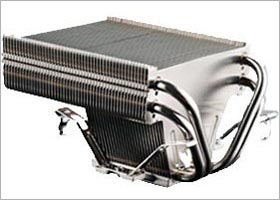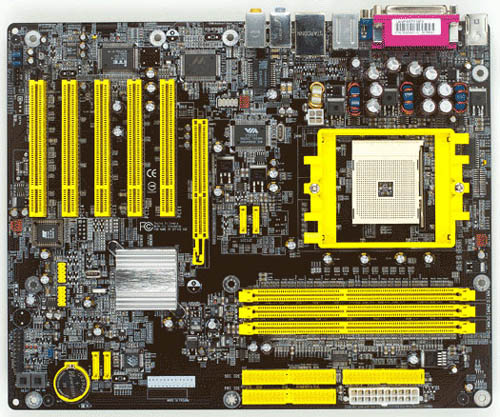Overclocking Buyer's Guide - September 2004
by Wesley Fink on September 17, 2004 12:05 AM EST- Posted in
- Guides
CPU and Motherboard: VALUE OC Recommendations
CPU: AMD Athlon 64 3200+ Retail (2.2Ghz, 512k cache) or AMD Athlon 64 3200+ Mobile (2.0GHz, 1MB Cache)Motherboard: DFI LANParty UT nF3 250Gb
Price: CPU - $213 shipped (Retail). Motherboard - $137 shipped
For the first time, an Athlon 64 socket 754 gets the nod as our Value OC favorite. With most recent Athlon 64 reaching around 2.5GHz or higher, the task was finding an A64 that gave great value and also had a real history of significant overclocking. AMD, like Intel, has different flavors of A64 available at the same clock frequency. It was pretty easy to see that the 3200+ offered great value and great overclocking abilities, but the question was which 3200+. There are now 3 varieties of 3200+ - the original 2.0Ghz with 1MB of cache, the updated 2.2Ghz with 512k of cache, and the new mobile A64 at 2.0Ghz with 1MB of cache.
Since Overclocking goals may be a bit different for different end-users, we chose two 3200+ Athlon 64 CPUs, each of which sells for about $213.

The latest 3200+ is based on the update Newcastle core and runs at 2.2Ghz with 512k cache. We have found the newer 3200+ to be a particularly good overclocker with most users reaching 2.5Ghz with relative ease. Some reach much higher than this OC. We selected the retail version of the 3200+, which comes with the competent AMD HSF made by Ajigo.

If you prefer a little cooler CPU with lower rated wattage consumption, the 3200+ mobile is an excellent choice. While this A64 is rated at the same 1.5V as the desktop 3200+, it is specifies at lower wattage, at stock speed. This translates into lower heat and a likely higher overclock. The Value OC DFI LANParty UT handles the mobile 3200+ with ease, something that cannot be said of many other socket 754 boards.
Please keep in mind that the mobile A64 does not have a heatspreader and therefore, the height is a bit shallower than the stock desktop 3200+. Many HSF do not provide adequate contact with the core of the mobile. A solution that is reported to work fine with the mobile A64 is the Thermalright XP-90.

The XP-90 replaces the Athlon 64 cage with a cage more like the Pentium 4. In fact, the Thermalright will work with either CPU. Since the attachment springs have great range, it is easy to get the kind of core contact required to cool the mobile A64 properly. The XP-90 supports a 92mm fan, so you can select a big, high output fan that moves a lot of air at slower, quieter speeds. If you want a 120mm fan, the more expensive XP-120 supports that option. While the XP-90 fits any board that we have seen, the massive XP-120 is very picky about lots of CPU space for mounting. Take a close look before you move to the 120.
While the 3200+ and mobile 3200+ both cost $213, you will need to add the XP-90 HSF and a 92mm fan to the cost of the mobile 3200+. That adds about $55 to the total. Your reward is that the mobile will likely run cooler at stock and it will also likely overclock even further than a desktop 3200+. You also get a full 1MB of cache instead of 512k, which can be important in games like Doom3.

As we clearly saw in our recent review of the DFI LANParty UT nf3 250Gb, this is a board that is likely to become an overclocking legend. If you plan to overclock a 754, this is the board to choose. No other 754 has come close to the DDR616 1:1 memory performance that we achieved on the DFI. It also has the overclocking features and extended adjustment ranges that will put a smile on any overclocker's face.
The DFI is another Gold Editors choice, and it earned this award with overclocking prowess that stood out from the crowd. No other production 754 offers the overclocking control of the LANParty UT, which is why this board now tops the Orb at Future Mark for 3DMark2001SE. You can do a lot with a late 3200+, and the DFI will take your CPU and memory to levels no other board can reach. It also does it with an ease and stability that you will grow to admire over time.
It took quite a board to push out the legendary Asus P4C800-E as the Value OC champ, but the DFI has what it takes. Please take a close look at our review, DFI LANParty UT nF3-250Gb: Overclocker's Dream, and the recent roundup, Socket 754 Roundup, Part 3: Asus, Soltek & DFI for a clear idea of the true capabilities of the LANParty UT.
Listed below is part of our RealTime pricing engine, which lists the lowest prices available on the Intel CPUs and motherboards from many different reputable vendors:
If you cannot find the lowest prices on the products that we've recommended on this page, it's because we don't list some of them in our RealTime pricing engine. Until we do, we suggest that you do an independent search online at the various vendors' web sites. Just pick and choose where you want to buy your products by looking for a vendor located under the "Vendor" heading.










31 Comments
View All Comments
jeeptrkr - Friday, December 10, 2004 - link
Perfect timing and very infomative article. I'm looking to buy a MSI K8N Neo2 Platinum w/ an AMD 64 FX-55 cpu.How would Crucial Ballistix PC4000 2.5-4-4-8 compare to PC3200 2-2-2-5 on the MSI mb? Faster bandwidth ver tighter timings?
decptt - Thursday, September 30, 2004 - link
Thank you, Fink.I ran Athlon64 Mobile 3200 2.0@2.55 Vcore 1.8
I will drop to 10x250 vcore1.7 for safer :>
Ballistix run@ 1:1 2.5-4-4-8 (I don't want to set 2.5-3-3-5 like the review for make sure that it works fine)
I'll tell the testing result again.
P.S. I had reached to 10x260 V1.8, windows works but Prime95 doens't work stable.
southernpac - Sunday, September 19, 2004 - link
Wesley,If Raid 1 is used (mirrowing), is the slow down negligble for a simulations gamer - or would it be noticable? Would the same be the case with 7,200 rpm SATA's?
I also notice that you listed the eVGA 6800, but the July High-End Guide listed the Gigabyte 6800 (Ultra). Have you noticed performance or manufacturing differences between the 6800 vendors?
The photo of the Crucial Ballistik PC3200 512 memory has a CL113V.X1 part number on it. I can't find that part number listed on the Crucial web site. ? Bill Mackay
thebluesgnr - Saturday, September 18, 2004 - link
This is one interesting article, but I wish it had the same idea of a "Value" system as other AT articles. The Value system of this guide is too much for me, here's what I came up with:AMD Athlon XP Mobile 2400+ 45W $77
ASRock K7V88 Raid $44
512MB (1 X 512MB) Corsair Value Select DDR400 CAS2.5 $79
128MB GeCube Radeon 9550XT $99
Antec SLK3700-BQE Black ATX Midtower w/ 350W PSU $90
Seagate 80GB 7200RPM SATA (8Mb Cache) – ST380013AS $71
HSF not included, total of $460.
One could change that system to a Chaintech VNF3-250 + Sempron 3100+, but I would rather upgrade the video card first.
PrinceGaz - Saturday, September 18, 2004 - link
#25 Wesley Fink- its great to hear a Value RAM roundup is being planned, listening to and where necessary addressing your readers comments is one of the main reasons AT is such a valuable website.Gholam - Saturday, September 18, 2004 - link
You have a mistake on page 13 - you list CM Stacker as an all-aluminium case, while it definitely isn't. It has aluminium panels, but the chassis frame is made of steel. It also weighs 14.9kg... ouch. On the other hand, there is no other case where ducting the PSU is as easy...Wesley Fink - Saturday, September 18, 2004 - link
#24 - I mentioned in the Value conclusion that you can cut $300 by choosing a cheaper case and an ATI 9800 PRO instead. Perhaps I should make those recommendations part of the Value OC chart in the future.#22 - I recommended one 512MB stick of Crucial Ballistix to get the cost down on the lowest priced system and still have great overclocking. We do plan a Value RAM roundup in the future.
cnq - Saturday, September 18, 2004 - link
Wesley,Keep up the good work!
Only nit is that like last time, you "forgot" (maybe it was intentional) to present a value video card. The price of the video card stuck out like a sore thumb in the summary pricing table for the value system!
The power requirements are ugly, but consider putting the 9800pro in the summary table for the value system next time. Until the X700XT and 6600GT's come out (and in AGP), you can't do better for $190. [Or at least you could have downshifted from a 6800GT to a 6800 to save a hundred bucks on the value system.]
ksherman - Friday, September 17, 2004 - link
you know what would kick arse? doing comparison tests! Compare all the different rigs you guys reccomend and see who the winners are. i.e. Performance OC vs your high end setup etc.PrinceGaz - Friday, September 17, 2004 - link
I really don't know why anyone here is so keen on the Sempron 3100+. You'd be a fool to buy one when the A64 2800+ is available at only a slightly higher cost, has twice the L2 cache, and most importantly 64-bit support. Anyone who buys a Sempron 3100+ today will regret it in a year or two when x86-64 Windows is supported.If you only keep a CPU for a year or so though, it makes even less sense getting something like the Sempron 3100+ with hopes of high overclocks unless you like always having an overclocked substandard processor.
The non-high end memory issue is important and really needs to be covered, CAS 2.5 modules form the likes of Corsair are available at very competitive prices compared to CAS 2 modules. We need an article that looks at CAS 2.5 and also CAS 3 PC3200 modules from the major manufacturers so we can see how far they overclock, and at what voltages and timings. Most people don't buy CAS2 modules unless they're getting a top of the range CPU (2.4 GHz A64 or 3.2+ GHz Prescott), so if you look at an A64 3200+, you need to look at the memory most people will use with it.